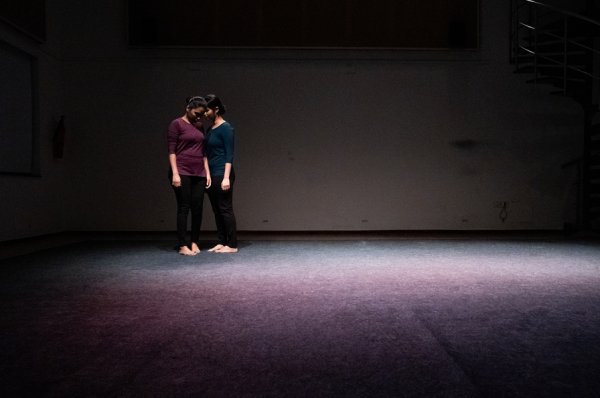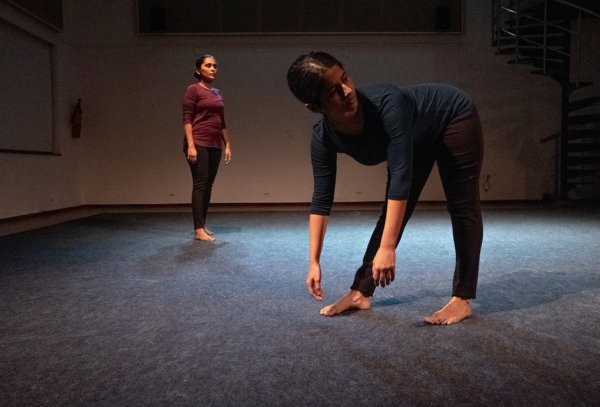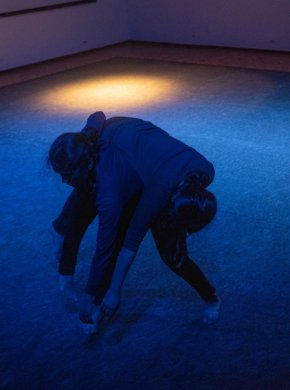
|   |

|   |
What Talk of Body - A dance embodying the separation of selves - Meera and Madhushree e-mail: meerasrikant@gmail.com / pupai.madhusree@gmail.com Photos courtesy: Sridhar Balasubramaniyam August 18, 2022 What Talk of Body Choreography and text: Anoushka Kurien Music: Akila Light: Vignesh Kumulai Aug 6, 2022, Goethe-Institut Chennai auditorium Jointly presented by Basement 21 and Goethe-Institut / Max Mueller Bhavan Chennai as part of the Basement 21 @ Goethe-Institut endeavours. What Talk of Body, performed by Chennai-based dancers Anoushka Kurien and Akila brings its audience back to contemplating what the motivation behind experimental dance is in India today. The merits that the contemporary dance choreographers achieved in the eighties and nineties, the impediments they faced while Indian dance went through strong philosophical and structural changes in different pockets in the country - what parts of these have been retained and what has shifted in the last few decades? Modernization of dance in India questioned the dependence of dance on the codification of gestures and facial expressions. In that framework, the question - "What Talk of Body?" - is fundamental and eternal.This particular work is based on a text, in which this question is not simply floated on its own but is suffixed by a very contemporary pain and even borderline panic that engulfs the generation that Anoushka and Akila belong to. A generation caught between the short-lived fašade of post-liberalization stability and the outwardly over-socialized and inwardly alienated existences within the late-capitalist uncertainty. "what talk of body? what talk of body when a hand is 3D printed? [...] what talk of shared pleasure? in the viral video. and what talk when the dead are revived in newspapers and not as they drown in the sea?"  Contemporary dance never ceased to ask such questions, but the suffixes kept changing. In this work, the questions are asked metronomically, repeatedly, breaking syllables down into pieces - like identities chopped off into smaller and smaller chunks between the varied degrees of reality and virtuality. Every metro in India has its own history of contemporary dance; its own styles of, and reasons for, developing techniques. The Chennai contemporary dance community has been known for the strong presence of women choreographers. It has also been known for an apparent structure of count-based, pattern-based creation. But beneath that structure, there has also been a constant latent search - social, political, philosophical, anatomical and ways to connect all this. The search for new technique is never far from these searches. What Talk of Body bears these trademarks in good and not-so-good ways. As the artistes themselves say, the work is still a work-in-progress in a manner. It indeed leaves the audience curious as to how and whether it wants to merge the various philosophical, political and technical expeditions that the text and two bodies and the two voices have the potential to perform. It also sometimes binds the audience by a certain monotonicity of counts and patterns that perhaps awaits an "interruption" made by different uses of space, sound and light. But a dance is not just a performance or two, it is a process. The gaps present in it on certain days of performing do not make this work less "moving", as an audience member mentioned during the post-performance conversation. Rather, they indeed make a curious audience look for "meanings" or "intentions" and in the process indicate towards new ideas. Because contemporary dance does not end with the claps, it lives on within the conversations and exchanges of ideas. Therefore, just as any performance arena, any arena of conversation about the performance must be owned by the artistes as well as the audience. One of the things that touches the most is the attempt of Anoushka - the writer and the choreographer - to walk away from grandeur and base her faith in communities and equal collaborations, which is much more difficult than said, and puts an immense responsibility on all the involved artists and technicians. Democracy and creativity do not go well hand-in-hand, but it is always exciting to experience glimpses of processes that attempt it. Especially in a work like this that has been created over years, bit by bit, carving its way out through the pandemic, through foreseen and unforeseen obstacles and losses.Especially in a sci-fi-coming-to-reality era, when robots performing a Kshetrayya Padam or The Rites of Spring to perfection is not anymore a faraway nightmare, when identity does not live in the mind or the body but in the labyrinth of virtual recognition. "what talk of cuddling a child across seas through a screen. what talk of body if her hips are weak from twerking or from sitting on a yoga block? and yours are tired from watching? what talk of diversion when attention is rounded up to be economised."  And in that line, what also moves the audience is how the dance uses this idea of dislocation and alienation in the constant separation of body and body, body and voice, voice and voice, voice and text and then attempts to merge them back together in silence, contact and trust. A trust that always comes across in the body if it exists in the heart of the process. An installation of the text outside the auditorium adds another layer. The separation is a theme that Anoushka has been deeplyinterested in since the beginning of her choreographic career. Having worked with shadows and digital screens earlier, it is this separation and the closing of it through "overlays of word, sound and action" that makes the broad structural narrative of What Talk of Body. The always delicious subtlety of movements on Anoushka's part are contrasted by Akila's calm rootedness that leaves space for exploring more in the coming performances. "yet since we repeatedly choose this uneasy living over the ignorance in dying there must be some talk left in body"  Some talk must be left in the body. For contemporarydancers and choreographers, this does not change. Unfortunately, many of the difficulties that they faced since time immemorial in keeping this fundamental spirit up, remain intact. A piece of art is not solely an individual's doing, nor responsibility. In art, one form keeps the other alive and that is how art grows - by questioning and re-questioning. What Talk of Body is placed in today's Chennai - a gigantic artists' hub. And yet, almost every experimental work suffers from a lack of a larger community support, unavailability of affordable rehearsal spaces, light and sound and most lamentably, a vibrant community. This work too has had its share of the same struggle. Therefore, it is even more heartening that this particular performance has been blessed to have not only a range of engaged audience members, but also an interesting collaboration between the dancers and Vignesh Kumulai, a light designer from the Kovilpatti-based theatre group Manalmagudi. It remains for us to see where such interesting engagements and collaborations take this work in the future. Meera and Madhushree are dancers and writers based in Chennai. |